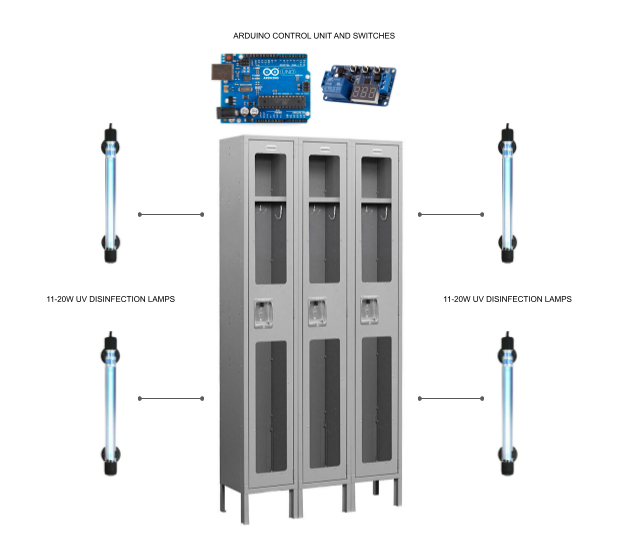Outer garment Self-sterilizing storage system for the food industry.
Introduction:
Many positions along the food production chain include work in humid environments managing the processing of food. This is especially true for meat packers, abattoir workers and fish processing plant operators. Under standard procedure most of the workers wear outer garments which frequently include rubber and nylon fibre based components [1]. As such, the cleaning and sterilization of such garments frequently exclude high pressure and high temperature laundry. Although in normal condition cleaning based on chemical products manages to greatly reduce most of the contamination risk, in the current period of COVID-19 risk this is not always the case (article 1).
The humid environment which results from the extensive use of water during the processing, the stable temp. (12o C) required for meat conservation and the high amount of organic material (draining liquids, blood dirty water etc.) [2] all contribute to an environment extremely conducive to the spread and survival of enveloped viruses such as the COVID-19, with CDC data confirming the dangerous trend (SDS report). Not surprisingly, amongst the worst cases of infection in the US were meat processing plants, with hundreds of contagions within several days (figure 1). A secondary risk linked to such contaminations is the disruption of food production chains. Farmers become desperate with cattle overcrowding pastures and feedlots while in the supermarkets a shortage of meat is noticed. The same reasoning is applied to other food processing facilities, fisheries and hydroponic production systems. Therefore, improving the sterilization procedures of the individual worker has a key importance both for human health, and a functioning food supply.
Figure 1: Meat processing plants and respective COVID-19 infections, Source: https://www.nwitimes.com/news/watch-now-meat-industry-butchered-by-covid-19-in-the-midwest/article_bae39958-d20b-58df-ad57-9f1094eeae52.html
Proposal layout:
As the main goal is to reduce possible contamination of non-washable outer garments we propose self-sterilizing storage compartments. Studies show that UV light anti-septic treatments at a wavelength of 254nm is extremely effective against common pathogens [3, 4] .Therefore, a system based on UV lamps positioned in adapted structure where the garments could be treated in addition or following a standard sanitation procedure (Figure 2). Further sterilization could also be done during off-hours, as part of a passive sanitation procedure for the following working day. This could be achieved using a 30 min to 1hr time frame, as it is all that needed for the disinfection process to work. Dedicated smart switches controlled via Arduino unit can ensure no energy is wasted on further irradiation or while the storage compartment is empty.
Figure 2: Basic concept description of self-sterilizing storage system based on time controlled limited UV irradiation patterns.
Technical layout:
Components:
-11-20W UV sterilization lamps (254nm wavelength)
-Arduino MCU
-Arduino switches (close/open/timer)
-power unit (portable/ grid connectable)
Team:
- Pierfrancesco Di Giuseppe: An environmental engineering student, maker and freelance coder with previous experience on microelectronic platforms.
- Michael Odintsov-Vaintrub: A DVM and an Animal husbandry PHD student with a formation focused on PLF technologies.
Further considerations:
Far-UV wavelengths between 207-222 nm are also being considered for this project predominantly for their cost –effectiveness properties. Studies have shown that a very low dose of 2 mJ/cm2 of 222-nm light inactivating >95% of aerosolized H1N1 influenza virus [4]
- 1. B. J. van Holland, R. Soer, M. R. de Boer, M. F. Reneman and S. Brouwer, Workers' health surveillance in the meat processing industry: Work and health indicators associated with work ability, Journal of Occupational Rehabilitation 25 (2015), no. 3, 618-626.
- 2. A. S. Tirloni, D. C. dos Reis, N. F. Dias and A. R. P. Moro, The use of personal protective equipment: Finger temperatures and thermal sensation of workers' exposure to cold environment, International Journal of Environmental Research and Public Health 15 (2018), no. 11, 14.
- 3. E. McGivney, M. Carlsson, J. P. Gustafsson and E. Gorokhova, Effects of uv-c and vacuum-uv tio2 advanced oxidation processes on the acute mortality of microalgae, Photochemistry and Photobiology 91 (2015), no. 5, 1142-1149.
- 4. D. Welch, M. Buonanno, V. Grilj, I. Shuryak, C. Crickmore, A. W. Bigelow, G. Randers-Pehrson, G. W. Johnson and D. J. Brenner, Far-uvc light: A new tool to control the spread of airborne-mediated microbial diseases, Scientific Reports 8 (2018).
Web resources:
- Meat packing related COVID infection spread: https://www.nwitimes.com/news/watch-now-meat-industry-butchered-by-covid-19-in-the-midwest/article_bae39958-d20b-58df-ad57-9f1094eeae52.html
- CDC report: https://www.cdc.gov/mmwr/volumes/69/wr/mm6918e3.htm
- Meat packing article 1: https://investigatemidwest.org/2020/05/06/meatpacking-industry-hits-grim-milestone-of-10000-coronavirus-cases-linked-to-plants/



